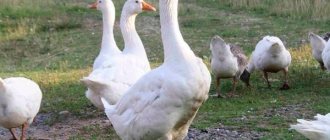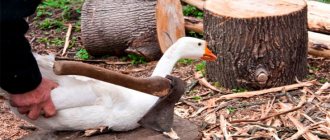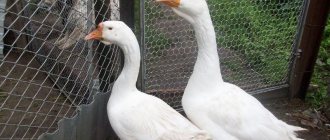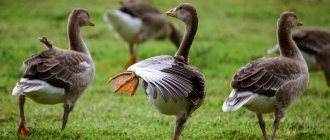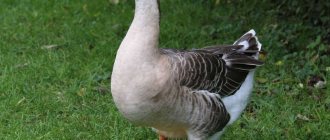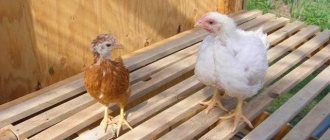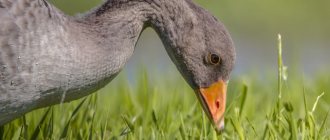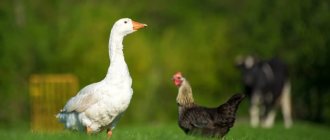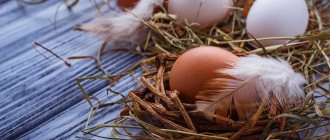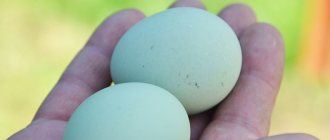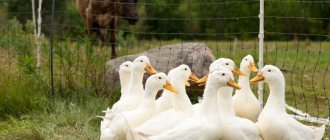Breeding geese in the country.
Breeding geese in the country is a very promising, profitable and low-cost business. If you live in a city apartment, but you have a summer house where you want to raise geese, then this article is for you.
You can raise geese in the country for different purposes: to obtain meat, eggs, as well as down and feathers. Of course, in dacha conditions, it is most likely not possible to breed geese on a large scale, but it is quite possible to provide your family with the healthiest products of goose farming. Caring for geese is not difficult, they are not picky about their living conditions, so why not try doing this exciting and interesting activity. From this article you will learn many details about breeding domestic geese in the country: in what conditions to keep them, what food to feed and how to properly care for them. Domestic geese
- This is a very early ripening bird. Just imagine, in just 2 months a gosling is able to increase its live weight by 40 times! Thus, by the age of only 2 months, a goose will already weigh 4-5 kilograms. Breed selection
Before you get geese for your dacha, you need to decide on the breed. It is necessary to choose a breed based on the purpose of breeding geese: if you want to breed geese for meat, then you should choose a meat breed accordingly. You can also proceed from your personal preferences. For larger-scale breeding, you should pay attention to fertile breeds of geese (Kuban, Chinese, Emdem), whose egg production is at least 75 eggs per year. Thus, from one adult goose you can get 40-50 heads of goslings per year, which after growing have a total weight of 150-200 kilograms. The ability to reproduce in geese remains for 4-5 years.
Keeping geese in a summer cottage
The room must be equipped with drinking bowls, feeders and nests. All these devices can be made with your own hands from wooden materials. Nests are installed in the dark corners of the poultry house at the rate of 1-2 females per 1 nest. Feeders are installed in the poultry house based on the calculation: the feeding front per head is at least 15 centimeters. Drinkers are installed based on the calculation of 5 centimeters per head.
At the dacha, geese can be kept in free-range conditions, that is, the geese come to the house only at night, and during the day they roam free. However, you should still make a small enclosure, just in case, which will limit the birds’ freedom. There are rainy days or for some other reason geese should not be released into the wild, in which case it is useful to confine them to a pen.
How and what to feed
Raising geese at home means preparing food for the winter in advance. During the summer period, you need to mow the grass so that there is about 15 kg of hay. Make a supply of succulent food up to 35 kg (carrots, beets). This is all based on one individual.
It is good to use various meadow grasses as hay. You can specially sow alfalfa or clover.
You can also make silage from greens; to do this, they are first fermented and then preserved. This mixture is equivalent to fresh greens, which has a positive effect on the digestive system in winter.
They also continue to appreciate food of aquatic origin, various twigs, birch, linden, aspen leaves, and spruce needles. If there is an oak tree nearby, you can stock up on acorns. Just before serving, they need to be dried, peeled and boiled for an hour. They are then crushed and mixed with grain crops.
If you want to balance the food as best as possible, dig up worms and place them in boxes of soil in the basement. And in winter, give it to the geese.
From the above, it becomes clear that breeding geese in the summer is much simpler than in the winter, but it is completely realistic. It may happen that you decided to simply keep geese to provide your family with meat, and then got carried away and started mass breeding. We can say for sure that all the material and emotional that you spend will come back to you in double amounts.
What care is needed for ducklings can be seen in the video:
Breeding geese in the country.
Breeding geese in the country is a very promising, profitable and low-cost business. If you live in a city apartment, but you have a summer house where you want to raise geese, then this article is for you.
You can raise geese in the country for different purposes: to obtain meat, eggs, as well as down and feathers. Of course, in dacha conditions, it is most likely not possible to breed geese on a large scale, but it is quite possible to provide your family with the healthiest products of goose farming. Caring for geese is not difficult, they are not picky about their living conditions, so why not try doing this exciting and interesting activity. From this article you will learn many details about breeding domestic geese in the country: in what conditions to keep them, what food to feed and how to properly care for them. Domestic geese
- This is a very early ripening bird. Just imagine, in just 2 months a gosling is able to increase its live weight by 40 times! Thus, by the age of only 2 months, a goose will already weigh 4-5 kilograms. Breed selection
Before you get geese for your dacha, you need to decide on the breed. It is necessary to choose a breed based on the purpose of breeding geese: if you want to breed geese for meat, then you should choose a meat breed accordingly. You can also proceed from your personal preferences. For larger-scale breeding, you should pay attention to fertile breeds of geese (Kuban, Chinese, Emdem), whose egg production is at least 75 eggs per year. Thus, from one adult goose you can get 40-50 heads of goslings per year, which after growing have a total weight of 150-200 kilograms. The ability to reproduce in geese remains for 4-5 years.
Feeding geese at the dacha
Feeding geese in the country is not at all difficult. Taking into account the fact that the geese will be kept free-range, they will receive most of the daily ration themselves. Despite this, the goose will in any case have to be fed 1-2 times a day. The most convenient way is to buy feed for geese and make various wet mashes based on it. Geese breeding
Domestic geese are birds that have a highly developed herd instinct and live in families. The parent flock must be formed, guided by the calculation of 2-4 geese per 1 young gander. A gander at an older age is capable of caring for only 1-2 females. That is why it is advisable to renew the parent stock by 20-30% every year.
The breeding season for geese usually begins in early to mid-March. Then the ganders begin to care for the geese and show more interest in them, and the females begin their egg-laying. By the time the female has laid enough eggs, she sits on them and begins incubation. At this time, the goose needs to be ensured complete calm and privacy. Incubation of goose eggs lasts about a month. After which little goslings are born. After hatching, the shell must be removed from the nest immediately.
After the goslings have dried, they need to be fed. The first feeding is made with boiled and chopped eggs or low-fat cottage cheese.
A very serious problem in breeding geese in the country is disease. The most dangerous are infectious diseases that can lead to mass mortality of livestock. Most often, diseases occur due to improper feeding or maintenance.
Source
Diseases in winter - how to avoid?
In winter, geese may experience three problems:
- weakened immunity due to an unbalanced diet. You need to make sure that the feed contains useful substances and vitamins, and if you have a shortage of root vegetables, silage, etc. on your farm, you can add fortified supplements;
- “stagnation” of poultry due to lack of free range. Take the herd out in any weather (except for critical temperatures), especially since sunlight is an excellent preventive measure against the development of rickets;
- colds, inflammation of the frontal sinuses, sinusitis. Geese are not afraid of frost, but as already mentioned, they are susceptible to drafts, so make sure that no gaps form. If the bird does get sick, it must be moved to a warm room and treated with sulfa drugs and antibiotics.
Keeping geese involves minimal costs compared to the returns. If you decide to try to get this animal, you will win in any case, even if you choose only the “summer” option. And as a reward you will receive delicious meat, healthy goose liver, valuable feathers and down, which can be used on the farm or sold.
Geese breeding
Among poultry, geese occupy second place after chickens. Birds with webbed feet are unpretentious: even novice poultry farmers can breed geese at home.
Geese are raised to produce tasty soft meat, liver, eggs, and soft down. Before you start raising this poultry, you need to think about choosing a breed.
Some species can be aggressive and need to be tamed before 6 weeks of age. The owner must visit the goslings several times a day so that his charges know him by sight.
Necessary equipment
The arrangement of the poultry house does not end with just litter. Feeders, drinking bowls, and nests should be placed. It would be nice if there was an extension nearby where you could store cleaning tools.
Dry food can be poured into boxes made of wood or plywood, but for wet food, it is better to purchase metal containers.
The size of the feeders must be impressive, otherwise the geese will crowd around them and not let each other eat.
The water in drinking bowls should be changed regularly; if it is contaminated, various infections and viruses may appear. Therefore, care must be constant. A variety of containers can be used as drinking bowls, ranging from a regular trough to cut pipes.
Geese are very active near water, so to prevent the bedding from getting wet, drinkers are placed on special trays. In cold frosty times, drinkers are filled with hot water to prevent freezing.
Nests are pre-prepared for geese. This needs to be done a month and a half before egg laying begins. During this period, the goose adapts to the new place and remembers the location. There should be no more than three individuals per nest.
To build a nest at home, it is fashionable to use, for example, a basket or a wooden (plywood) box. A wicker tray is placed inside the resulting nest. It will make it easier to remove the eggs.
How to breed geese?
A flock of geese is replenished with young animals in two ways:
Breeding chicks by a hen
This method is preferable because it is more natural. One goose hatches no more than 14 eggs, as they are large.
When incubating, the hen's body should completely cover the eggs.
What you need to know:
The chicks appear on the 28th day. The very first ones are placed in a box under a lamp. After the entire brood has emerged, the chicks remain with the goose. In the evening, you can quietly add hatchery goslings to the brood. They will appreciate maternal care.
Incubator
Raising goslings at home in an incubator is more difficult than raising chickens. Geese eggs contain fat and are larger. Therefore, when chicks hatch from 70% of the eggs in the set, the result is considered good.
Peculiarities:
Natural hatching of chicks
If geese are kept in a poultry house for the purpose of further breeding, it is necessary to arrange nests in the optimal quantity.
Nests can be made from plywood or wicker baskets with bedding changed frequently. Those geese, as a rule, have one nest, located in an insulated place away from direct sunlight, preferably in a separate room from the rest of the birds. Optimal dimensions of the nest:
- height - about half a meter;
- length – 65 cm;
- width – 40-50 cm;
- threshold height – no more than 10 cm.
The average incubation period for eggs is about a month. Usually the chick hatches on the 28th day.
The most common egg breeds of geese
Read
Decorative geese. The two most beautiful breeds
More details
Contents of goslings
If the chicks are kept without a brood hen, the temperature in the room must be maintained, changing as the goslings grow:
Keeping in a warm room can last up to 30 days depending on the season and weather.
Weak individuals are kept separately and given enhanced nutrition. If the gosling falls, you need to help him get up on his legs; he should not lie on his back for a long time.
The premises are equipped according to the following rules:
After 20 days, the goslings live with the young, no more than two birds per 1 sq.m. Waterfowl geese love water. The presence of a pond improves the quality of life of geese.
Feeding recommendations
The most profitable type of fattening is keeping geese on pasture. But grass alone is not enough; birds need concentrated feed. Norms and diets depend not only on the season and weight of the birds, but also on the purpose of rearing.
Fattening of young animals
The goslings are given food immediately after being placed in the brooder. At first, they are fed at least 6 times a day, gradually increasing the intervals between feedings and reducing their number to three by the time the chicks reach 2.5-3 months of age.
For the first 3 days, babies are given boiled chicken eggs. It should be borne in mind that at high temperatures the product deteriorates very quickly, so it is replaced with fresh one as often as possible.
The main cause of disease in goslings is poisoning from spoiled foods. In a brooder, eggs and cottage cheese should not be left for more than 30-60 minutes.
At the initial stage, instead of feeders, polyethylene lids from jars or saucers up to 1.5 cm deep are used. On the 2-3rd day, they switch to deeper containers or specialized feeders for young poultry.
Starting from the 3rd day, low-fat cottage cheese, bread, and greens are introduced into the diet (plants rich in phytoncides, for example, onions and wild garlic, are of particular benefit). By the 10th day, babies are switched to porridge. Starting from 3 weeks of age, goslings are allowed to graze in the fresh air, where the basis of their diet is already fresh grass. During this period, complementary foods are given in the form of dry crushed grain or mixed feed in the morning and evening.
This type of fattening is used by many poultry farmers. If you introduce new products smoothly and monitor their quality, then problems with the health of the bird should not arise. But you won’t get high growth rates either. Experts advise adhering to a scientific approach based on the consumption of proteins, fats and carbohydrates. An approximate diet for chicks in the first month of life is presented in the table (values are given in grams per 1 head per day):
| Name | Age (days) | |||
| 1-5 | 6-10 | 11-20 | 21-30 | |
| Corn | 15 | 21 | 41 | 96 |
| Bran | 3 | 6 | 13 | 40 |
| Roots | 5 | 20 | 20 | 20 |
| Greenery | 20 | 60 | 60 | 100 |
| Serum | 25 | 50 | 50 | 50 |
| Bone flour | 2 | 4 | 14 | 28 |
| Shell/limestone | 0,3 | 0,5 | 1 | 4 |
This list of ingredients takes into account all the basic nutritional needs of the gosling. But still, experienced poultry farmers recommend giving additional vitamins in the minimum dosages suggested by the manufacturer.
For root vegetables, it is preferable to use fresh carrots, which are first finely grated. Whey can be replaced with skim milk. Bone meal is a priority, but if it is not available, meat and bone or fish meal will do.
Grain (wheat or barley) is given only in crushed form
Let's consider another option for preparing a feed mixture for goslings:
| Name | Age (days) | |||
| 1-5 | 6-10 | 11-20 | 21-30 | |
| Corn | 15 | 15 | 30 | 35 |
| Bran | 3 | 5 | 15 | 40 |
| Greenery | 5 | 30 | 60 | 130 |
| Boiled potatoes | 0 | 20 | 40 | 100 |
| Serum | 25 | 50 | 0 | 0 |
| Cake | 0 | 4 | 15 | 25 |
| Bone flour | 2 | 7 | 15 | 30 |
| Shell/limestone | 0,3 | 0,5 | 1,5 | 2 |
This diet includes boiled potatoes (or peelings), as well as cake (preferably sunflower), which is more economically profitable, but involves more hassle with preparation. In addition, you will have to increase the dosage of vitamins, since fresh root vegetables are excluded, and adding more green mass will not provide the desired effect.
Commercial feed often has to be ordered from online stores
When intensively fattening young animals for meat, some farmers use specialized feed from the first days of babies’ lives. According to reviews, goslings grow noticeably faster on industrial mixtures than on homemade ones, and as a result, the additional costs quickly pay off. It is worth keeping in mind that in some regions it is very difficult to find feed for geese on sale in an acceptable price range, since there is practically no demand for them.
Feeding adult geese
There are usually no problems with feeding an adult bird. Geese graze in the meadow all day, eating plenty of greenery. Additionally, they are given grain or feed. Many owners fearlessly add table scraps (without a lot of salt and spices), including animal products.
Additional complementary feeding is provided twice a day: it is recommended to give compound feed in the morning, and whole grains in the evening. During the day, the bird should have free access to green and succulent food. No vitamin and mineral supplements are required. With a concentrated type of feeding, one individual receives 0.3-0.4 kg of compound feed, with a mixed type - 0.1-0.15 kg.
In winter, fresh greens are replaced with dried grass, nettles, birch brooms, and harvested seaweed.
In winter, the birds are fed a large amount of succulent food: cabbage, carrots, beets, pumpkin and other products in crushed form - chopped or grated on a coarse grater. In addition, it is useful to add boiled potatoes and bread. It is mandatory to use vitamins, as well as chopped hay (dry or steamed). Some poultry farmers prepare silage or haylage.
Before the onset of the mating period, the bird is transferred to 4 feedings a day. Protein standards for ganders are increased by introducing oats (60 g per head per day) and fish meal (10 g) into the diet in combination with vitamin and mineral complexes. Geese need shell or limestone during this period.
Poultry house
Year-round breeding of geese is impossible without a convenient poultry house. Birds should feel comfortable and live in safety. For each adult you need to have 1 sq. m area. Crowding and darkness cause egg pecking and feather loss. The site for the poultry house is chosen to be dry and level.
When building an enclosure:
Geese tolerate cold well, but the temperature should not fall below +5°. There should be no drafts in the goose house, because geese cannot stand them.
An exhaust hood is required to maintain moisture levels. Natural light is not enough; electricity is a must. The lamps are suspended at a height of 2 m, 60 W per 6 sq. m. m. Lighting should be moderate and uniform.
Geese need a walk. If there is no body of water nearby, install a container of water for swimming.
Walking conditions
Geese require regular walking.
Flood meadows, stubble, areas where clover, legumes, sorrel, nettles, dandelions, and cereals grow are suitable for grazing. The main thing is that the walking area is as spacious as possible, so that the birds have the opportunity to move more and process pasture.
Water
For breeding geese, the presence of a reservoir is not a prerequisite. Of course, a good, clean reservoir with rich vegetation will be a definite plus, but rapid weight gain, the number of eggs, and health depend, first of all, on the conditions of detention. If you provide the birds with good nutrition and proper care, the birds will easily survive the lack of a reservoir.
When arranging a bathhouse for geese in the yard, the following conditions must be observed:
- Possibility of water renewal. Non-renewable water blooms and is quickly polluted by birds.
- Arrangement of a gentle slope. It will be easier for adult birds to descend into the water, and for young birds to climb back onto land.
Large basins and troughs are suitable for bathing areas.
Differences between summer and winter feeding
The diet of goose varies depending on the season. In summer, geese eat green grass; in winter, it needs to be replaced with silage. Feeding geese in the summer is cheaper and easier.
It is enough to feed wet and grain food once a day. In winter, this must be done 3 times. Root vegetables are needed in winter. A winter replacement for green grass is pine or spruce needles ground in a meat grinder.
The period of raising geese should not be very long, because the quality of the meat deteriorates. Usually 4 months are enough for the goose to gain sufficient weight.
Keeping geese requires expense and labor, but brings good results.
Source
Common diseases
Geese are susceptible to diseases that affect waterfowl.
The most common diseases are the following:
- Coccidiosis . This disease often affects young goslings. It manifests itself in the form of diarrhea, which causes dehydration and exhaustion of the body. Renal coccidiosis affects the kidney canals - in this case, affected individuals lose activity and appetite, sit with a ruffled appearance, which also leads to severe exhaustion. Coccidiostats (Baycox) and sulfonamide drugs are used for treatment.
- Pasteurellosis . This dangerous disease quickly affects the bird and often leads to its death. In this case, the goose barn is quarantined and all sick birds are slaughtered. Treatment is carried out with antibiotics and sulfonamides.
- Paratyphoid . In adults, the disease can pass without any symptoms, but goslings do not tolerate paratyphoid easily. Severe diarrhea, conjunctivitis, exhaustion, breathing problems appear, and the chicks begin to limp. Death occurs within 3-4 days. Paratyphoid fever is treated with antibiotics such as tetracycline and nitrofuran, but treatment does not bring results in all cases.
- Helminthiases . Geese can become infected with trematodes, cestodes, and nematodes. They are treated with anthelmintics and Ivermectin.
At low temperatures and drafts, birds can become ill with viral diseases that cause inflammation in the frontal sinuses and sinusitis. Antibiotics are used for treatment.
Non-contagious diseases of geese include hypovitaminosis, which occurs due to a lack of essential vitamins and minerals.
What is special about raising geese: revelations from a poultry farmer
Adding an article to a new collection
Geese are absolutely unpretentious birds. They grow quickly, gain weight well and lay large and healthy eggs. Therefore, keeping them is very profitable. Geese are often bred not only on large farms, but also on small private farmsteads.
Violetta Dvorskaya , a passionate poultry farmer from Volgograd, shares with us her experience of raising meat and egg geese.
Violetta, please tell us what breed of geese do you keep?
We mainly breed Lindovsky breed geese. These are large birds with white plumage. Lindovsky geese are a meat and egg breed. They are beneficial to keep because they grow quickly. At 4-5 months, birds gain weight up to 4 kg. Females in adulthood weigh about 7 kg, and males - up to 8 kg. In addition, geese lay up to 50 eggs per year.
Lindovsky geese are the most popular breed of geese among Russian farmers. These are fast-growing birds with a large, elongated body, white plumage and a peculiar bump in the forehead area. The birds' beaks and paws are orange in varying degrees of intensity. The eyes are small and dark in color. Linda's geese get along well with representatives of other breeds. Birds are distinguished by their contact, curiosity, and friendliness towards people and their own relatives.
Where do you recommend keeping small goslings?
The chicks are placed in a box or box with an infrared heater. If you keep the goslings in a very warm room, you can additionally use only a heating pad. Caring for chicks is quite a troublesome task. These tiny fluffy lumps do not yet have subcutaneous fat, feathers, and thermoregulation is not developed. In the room where the brood is housed without a brood hen, it is necessary to maintain a temperature of 28 to 30°C. The first day the goslings cannot even stand on their feet. Therefore, they need special care and attention. But already from the second day of life, the chicks begin to walk and run. It's very funny to watch them.
Is it possible to return the chicks to the hen house after some time?
When the goslings are 6-7 days old, the temperature in the place where they are kept can be reduced to 20-22°C. And in the warm season they can be moved to the house with the hen.
We had experience raising chicks during the first days of life in the house. I’ll be honest: we were able to withstand their presence for only two days. We had such a loud squeak! You can't even imagine how loud these little furballs can be! They squealed in the house, and the adult geese cackled outside. So we sent the kids to the goose, and everyone immediately calmed down. The goose took excellent care of the chicks, and they were comfortable. However, in the cold season, goslings need to be kept warm longer: only after two weeks can the temperature be reduced to 18°C. But if the hen is experienced, she will be able to warm the chicks and take care of them.
What do you feed your goslings at first?
On the first day you can only give water, from the second day we introduce the yolk, and on the third day - cottage cheese. After this, you can add greens, for example, chopped young onions or clover. The amount of greenery is increasing every day. You can include bread crusts, previously soaked in water, in your diet. Goslings should always have access to water. To do this, it is necessary to equip wooden drinking bowls with low sides. Chicks need water both for drinking and for washing their beaks after eating.
Goslings grow very quickly. Over the course of a few months, the chicks increase their weight tenfold and rapidly change in appearance. In the photo you can see how much the chick has grown in a month.
What conditions must be created for an adult bird to be kept year-round?
Geese are absolutely unpretentious birds. They feel great outdoors in any weather. They only need a canopy that will protect them from the sun and rain. Nests can be built under the canopy. And geese can be in such conditions at any temperature, down to –40°C. But if you want them to lay eggs better, you need to build an insulated barn where feeders, drinkers and nests will be installed. And the geese will go out for a walk. The more comfortable the living conditions, the higher the egg production.
Is your shed heated? What additional lighting do you use?
Our shed is heated with infrared lamps. A comfortable temperature for geese is 22°C. The main thing is to be dry and warm. For lighting we use a regular incandescent lamp. Lighting that is too bright is not necessary as the geese can become aggressive.
How to calculate the size of a gooseneck? How many birds can fit in 1 square meter?
The size of a goose barn is very easy to calculate: 1 square meter of area – one bird. If there is not enough free space, the geese will be uncomfortable. We must remember that these are not very clean birds, so you will have to clean them often.
Are there any rules for arranging the internal space of a goose barn?
The goose barn should have drinkers, feeders and nests. Drinkers must be installed so that water does not spill. It is advisable to make hanging feeders, since geese can trample the food and stain it with excrement. Hen nests should be installed in such a way that it is convenient to check and clean them. These can be boxes measuring approximately 70x70 cm and about 40 cm high. The wall on the front of the box needs to be made lower so that it is convenient for the goose to enter the nest. The bottom of the nest can be covered with straw. Mandatory rule: there should be no dampness or drafts in the poultry house for geese.
What do you use as bedding?
We use straw as bedding. Bird excrement passes through the top layer of litter and ends up at the bottom, which allows you to clean the house less often. However, it is not advisable to place straw with long, sharp stems to prevent injury to birds. The bedding material must be dry and not contaminated with mold fungi. Otherwise, diseases of the bird's respiratory tract may occur.
Geese are known to be waterfowl. If there is no reservoir on the site, how can access to water be organized? And how to properly equip a walking area ?
We set up a walking area near the poultry house, fencing it with a 1.5 m high net. We have a large container of water installed on this site. Geese love to splash around in it, splash it, and drink. Be sure to change the water every day. Geese drink not only from drinking bowls, but also from places where they splash, even from puddles. During the cold season, drinkers need to be cleaned with hot water.
You definitely need to make a canopy over the enclosure. Geese prefer not to sit in the barn, but spend a lot of time outside, especially in the warm season, during thaws and even slight frosts. Therefore, there should be feeders for grass and vegetables on the site.
What food do you give to adult geese?
We feed the geese a grain mixture of wheat, barley, corn and seeds. In the warm season, we give a lot of grass: about 2 kg for each goose. Geese happily eat seasonal vegetables and fruits; they love watermelons and melons. This feed is enough to provide the bird’s body with absolutely all the beneficial substances.
In the cold season, we give the geese hay, grain mixture, and boiled vegetables: potatoes and carrots. We introduce carrots into the food raw, after chopping them on a coarse grater; sometimes we add apples and leftover vegetables from our table. You can prepare brooms from vines and branches of fruit trees, and in winter, steam them, hang them, and the geese will happily pinch them.
Please tell us how a flock of geese is formed? Is it possible to keep birds of different ages together?
We divided the flock of geese: in one pen we have a pair of birds: a one-and-a-half-year-old gander and a goose with their brood, in another pen there are six-month-old goslings, and adults separately. For every male there are 5-6 females.
According to the rules, geese of different ages must be kept separately, since adult birds are unfriendly towards young animals: they peck at them and drive them away from feeders. And young birds are under constant stress, which negatively affects their growth and development.
Violetta, what can you tell us about goose eggs?
Goose eggs are very tasty and healthy. In size, each goose egg is 2-3 chicken eggs. However, geese lay eggs every other day and only for six months. Therefore, goose eggs are much more expensive than chicken eggs.
In the photo you can compare how much smaller a chicken egg (on the left) is than goose eggs.
Goose eggs are a dietary product. They contain vitamins K, D, E, A, as well as B vitamins, micro- and macroelements (calcium, potassium, copper, phosphorus, iron, sulfur and others). Eating goose eggs helps eliminate toxins, improve memory and visual acuity, and improves brain activity. The nutritional value of goose eggs is several times higher than chicken eggs.
What do you do with goose down? Do you use it somehow?
Geese have very soft down. If you set a goal, geese can be plucked, processed down and feathers and used to make pillows or sold as valuable raw materials.
If we compare caring for chickens and geese: which is easier to keep?
Chickens are definitely easier to keep. They don’t need to splash around, they don’t make so much dirt... And the most important advantage of chickens is that they are not so noisy. Geese cackle loudly at the slightest disturbance. And believe me, it is very loud! If we compare the benefits of keeping them, chickens lay eggs all year round with good care, and geese lay eggs from February to July. But geese differ favorably from chickens in their rapid weight gain. Over the spring and summer, you can raise large birds for meat.
It should also be noted that geese are smart birds that are capable of making friends with a person or, conversely, showing aggression towards someone. For example, we have a goose named Vasya, who responds to his name and comes up when called. He looks at everyone carefully and treats people differently. In this regard, geese are more interesting than chickens.
I love photographing my pets and often post photos and videos on my Instagram page.
There are many benefits to raising geese. If you decide to raise these wonderful birds, you can decorate any holiday with a dish of delicious domestic goose.
Source
Hatching egg
If you already keep a family pair of geese raised from purchased goslings, and want to breed them yourself, then you need to prepare the bird for the incubation period. Under good housing conditions, geese begin to lay eggs in February-March. And the main stimulator of oviposition is a long daylight hours of 12-14 hours. That is, the egg-laying of geese can be controlled and regulated, adjusting it to the optimal time of year for you.
For example, you want to hatch goslings in early April. To do this, the geese are artificially increased daylight hours to 14 hours in February, and by the beginning of March they begin to lay eggs intensively. To prevent the egg from becoming contaminated with droppings and the birds laying eggs in a strictly defined place, in secluded and darkened corners of the poultry house, nest boxes are installed. Up to 90% of all geese lay eggs in the first half of the day, and here you need to calculate this period and collect eggs from the nests in time. This is necessary primarily in order to avoid not only contamination of the eggs, but also their hypothermia.
Feeding geese to obtain high-quality hatching eggs
The next important point in obtaining high-quality hatching eggs for breeding is feeding the geese. Below, I will give a detailed table of feed supply, but now we are not talking about that. The fact is that it is important to maintain the golden mean, i.e. the bird should receive the maximum amount of nutrients, including vitamins, macro and microelements, and at the same time, the geese should not become fat. If geese have an excess supply of fat, then almost all the eggs they lay will be unfertilized. To obtain a high-quality hatching egg, geese need to be switched to the following diet:
- Oats – 80%.
- Cake, meal and peas – 15%.
- Fish and meat and bone meal, including various mineral and vitamin supplements (premixes) – 5%.
Advice. During the pre-incubation period, try to completely exclude barley from the geese’s diet. Barley makes the shell of goose eggs so strong that during the hatching period it is very difficult for small goslings to break through it.
As I already said, you need to collect the hatching egg every day and store it in a dark, cool place, at a temperature of 12-16 degrees Celsius. However, there are situations when you need to collect 30-40 eggs over a long period of time. And naturally, the first eggs collected completely lose their incubation properties. To prevent this from happening, the egg should be heated in the incubator every day at a temperature of 37-39 degrees. This is called the mother hen effect.
Let's take, for example, a hen that hatched 18-20 chicks in a secluded place, and she hatched them only from her eggs. And the chick hatch rate reached 100%. And then a natural question arises - how did she do it? After all, the time interval between the first and last egg laid is quite long. The explanation is quite simple: each time the chicken was going to lay a new egg, it warmed up the entire egg laying, extending the shelf life of the hatching eggs.
Before placing an egg in an incubator or under a hen, it is checked for cracks and obvious damage. For this purpose it is better to use an ovoscope. Eggs that are round, flattened or too elongated are also not suitable for hatching goslings.
Hatching goslings in an incubator
For artificial breeding of goslings, any incubator is suitable. However, hatching them in an incubator is not as easy as it seems. If chickens need to lower air humidity in the second week of incubation, then goslings need to increase it.
This is done using a room polarizer, which is used to spray the egg twice a day, starting from the 15th day of incubation. Well, otherwise, the whole process of incubating goose eggs is no different from chicken or quail eggs.
- In the first week of incubation, we maintain the air temperature within 38.5-39 degrees.
- In the second week, we reduce the temperature to 38.5-38 degrees.
- Third week - 38 degrees.
- The last seven days - 37.5-38C°.
In almost every goose hatch, there are goslings that cannot get out of the shell on their own. If you notice such a gosling, do not rush to release it immediately. First, illuminate the egg with the gosling using an ovoscope and determine whether the blood vessels connecting its umbilical cord to the shell have separated. If they separate, then feel free to pull it out and be sure to cauterize the umbilical cord with iodine. If you do this ahead of time, the gosling will inevitably die from excessive bleeding. For the first few days (until the umbilical cords are tightened), keep these goslings in a separate box.
Hatching goslings under the hen
Breeding and raising goslings under a hen is much easier than in an incubator. In this case, the withdrawal can reach 100%. But there are some nuances here too. Not every goose has a pronounced brooding instinct. If you want to raise goslings only under the goose, then purchase the following breeds of geese: Kholmogory, large gray, Toulouse and Italian white geese .
It is the geese of these breeds that are most prone to incubation. But constantly collecting hatching eggs greatly reduces the chances that your geese will lay eggs. Therefore, the real egg must be replaced with a dummy, which is made from any available material. For example, I made dummies of eggs from gypsum dry plaster and placed 5-6 eggs in a nest. And when he noticed that one of the geese began to tear out the fluff and line the nest with it, while remaining overnight in it, he placed real eggs under it.
This must be done at night, carefully and in complete darkness. Usually, 9-11 eggs are laid under each goose. When the time for hatching comes (usually on days 27-29), the hatched goslings are taken from under the hen, the nest is cleared of shells and the last gosling is awaited to hatch.
If on the 30-31st day the goose continues to sit on the nest, but the remaining eggs do not show signs of life (pecking, squeaking inside the eggs, light tapping), then the hatching of the goslings under the hen can be considered complete and the already dried and strengthened goslings can be allowed in to her. Also, goslings bred in an incubator should be allowed near the goose, as she can grow them up to 20-25 pieces. In the future, it is better to separate the goose with the brood from the main herd for 2-3 weeks, and until the young animals fledge, do not release them into the pond.
Keeping and raising geese at home
Geese are an unpretentious, productive bird, the raising of which is a profitable and exciting activity that does not require huge costs and investments, the construction of special complex premises and the creation of a special microclimate for their maintenance.
This strong bird is able to stay outside all year, using sheds or a small shed in bad weather, or for laying eggs.
Feeding geese is inexpensive and compound feed is needed only at the initial stage of rearing. When fattening poultry for meat and maintaining breeding stock, you can get by with available grain feed and any grass, including weeds.
Geese make excellent use of pastures and the water surface of reservoirs, spending the whole day walking and effectively processing pasture. They grow quickly and gain weight. With intensive fattening, the bird increases its live weight in relation to its initial weight by 30-40 times in three months, reaching a weight of 4-4.5 kg during this period.
But even extensive fattening - on grass and a small amount of grain feed - in six months will produce heavy birds weighing up to 5-6 kg or more, depending on the breed and gender.
Keeping geese for meat longer than six months is unprofitable. The bird enters the breeding season, loses weight and the meat becomes tougher. The deadline for slaughtering geese of spring or early summer incubation is December of the current or January of the next year. The optimal time for finishing fattening is October-November.
Which breed to choose?
Before you go shopping for the younger generation, think about what kind of geese you want to breed?
Most often, beginning poultry farmers prioritize meat breeds. Their choice is quite large, the most popular are Kholmogory geese, Lindovsky, Lansky, large gray, and Tula fighting geese. All these representatives are distinguished by rapid precocity. But at the same time there must be a proper and balanced diet, which will contain succulent feed and grain crops.
At ten weeks of age, the individual will reach about 4.5 kilograms.
The breed also has good survival rate of young animals, they are quite unpretentious, consume little food and, with good care, quickly gain weight.
Geese Raising Basics for Beginners
It is not difficult for day-old goslings to create suitable conditions; the main thing they need is a warm and dry room without drafts.
Crowded planting of young animals is unacceptable, as this leads to increased humidity, contamination of feed and water, the development of infectious and fungal diseases, inflammation of the joints, general weakness and loss of growth rates.
The minimum area for keeping small goslings is 8-10 heads per 1 sq. m. floor, for very large breeds a larger area is needed, they are planted more spaciously - 4-6 individuals per 1 sq. m. m.
Before the young animals move in, the room is prepared - cleaned after growing the previous batch, the walls are whitened with a strong lime solution, the floor is sprinkled with fluff lime, and then a bedding of fresh straw or wood shavings is laid.
In order not to unnecessarily disturb the goslings, at first the bedding is replaced only partially - at the drinkers, and the contaminated areas are sprinkled with a fresh layer of straw.
It is convenient to use an infrared lamp for poultry as a heater, which is suspended above the floor, the temperature is fixed at the level where the bird is located and the lamp is raised or lowered to achieve the desired values.
These lamps are available in a variety of types and power levels at specialty farm and pet stores. When used correctly, they are durable, practical and will last for several seasons.
Infrared lamp for poultry
Many poultry farmers make do with ordinary heating pads or bottles of hot water, wrapping them in fabric and placing them in a box with a fabric canopy; the chicks can hide and warm themselves under such an artificial hen.
For good growth and healthy development, it is very important to warm up and under no circumstances expose goslings to cold in the first week of their life.
When growing under a hen, make sure that the room temperature in the first ten days does not fall below 22 °C.
In the first days after acquiring day-old geese, the light is kept on for a full day so that they can eat and drink to their heart's content and become sufficiently strong.
The reduction in daylight hours is carried out gradually, bringing its duration to 14-16 hours by the age of one month. If the bird is kept for fattening purposes, as well as for non-productive breeding stock, during the period of autumn and early winter the day length should be 12-14 hours.
For goslings under 10 days of age, install standard automatic drinkers on a jar with a wide recess so that the beak fits into the groove and the gosling can drink normally.
To maintain dryness, from the third day the drinker is placed on a metal baking sheet with sides, on which a grate is placed on top.
For older young animals, any containers are used as drinking bowls at home, replacing the water once or twice a day. During the same period, in warm, windless weather, it is advisable to release the young animals into the enclosure, installing drinking bowls and feeders on the street, which will facilitate care, eliminate dampness and make the living conditions optimal.
To feed day-old goslings, trays with low sides up to 2.5 cm high are placed, and from the third day they are replaced with trough feeders.
From the age of one month, food is poured into feeders for adult geese, calculating their length so that the bird does not crowd, but can calmly take its place at the feeder, with the approximate length being 15 cm per head. If not all goslings are able to feed normally, sooner or later several underfed chicks will begin to weaken.
Typical feeder for keeping geese at home
A handle bar is attached along the wooden feeder, with which it can be carried, and on the other hand, the bar will prevent compaction and contamination of the feed.
Below are suggested microclimate indicators for keeping young animals at home.
Requirements for the conditions of keeping young animals
Adult geese are undemanding to temperature indicators and, with normal general condition, good fat layer and developed plumage, can be kept at sub-zero temperatures in winter. Moreover, in cool autumn and early winter weather, they gain weight well and form round, clean carcasses without stumps.
Preparing for summer maintenance
Let's look at a brief guide to keeping geese for beginners.
First of all, you need to prepare the room in which the geese will sleep. In fact, if you have experience in raising chickens, it can be applied to arranging housing for geese, because the principles are very similar.
- The sleeping area should be warm and dry enough for the birds to feel comfortable in it.
- Ideally, use a small barn where you can equip several floors with stairs. Geese will independently find roosts for the night.
To provide for the geese for the summer period, it is not at all necessary to erect and equip permanent buildings, because the geese will only spend the night in them. They spend the whole day outside, where they are quite comfortable.
Disease Prevention
Instead of treating a disease, it is better to prevent it in advance, especially since some infectious diseases can cause mass mortality of birds.
Experts recommend taking the following preventive measures against various diseases:
- Comply with sanitary and hygienic standards in the poultry house - such as maintaining cleanliness, disinfection of the poultry room, nests, and all equipment. Replace bedding regularly.
- Make sure that there is no high humidity or drafts in the goose barn.
- Regularly clean and disinfect walking areas.
- Carry out sanitary and epidemiological control of water bodies.
- Carry out the necessary vaccinations.
- Keep small chicks separately from adults.
- Regularly carry out deworming against parasites.
- Include greens and succulent food in the diet, as well as the necessary complex of vitamins and minerals.
- Balance the bird's diet; Ensure that the food is of high quality and fresh.
- To prevent the occurrence of infection, add coccidiostats to the geese's feed once a month during the warm period.
- If serious infectious diseases are detected, transfer sick individuals to quarantine. The same thing applies to suspected illness. Birds that are too affected by the disease must be slaughtered. Be sure to contact your veterinarian.
Did you know? Owners of geese often complain about the noise of these birds, but it was this quality that once saved Rome. The historical work of the ancient historian Titus Livy, “History from the Foundation of the City,” tells how in the 5th century BC the Gauls tried to capture the Capitoline fortress at night, but the geese, noticing them, made a noise and woke up the defenders of the fortress.
So, keeping geese is a troublesome task, but it pays off, especially if there is a pond or grazing area nearby. If you get down to business seriously, you can create a thriving business from scratch.
Arrangement of a gooseneck
What about the inventory? The set of equipment consists of feeders, drinkers, nests, and tools for cleaning the poultry house.
Dry food is often fed from wooden feeders, and wet mash from metal feeders. Feeding front (feeder width) – 150 cm/head. With a lower value of this indicator, weak individuals are replaced by stronger relatives and therefore lose weight.
Add to this fights, which are a stress factor for the entire bird population.
Geese that have reached physiological maturity are watered from wooden troughs, buckets, and cut iron or plastic pipes.
Females lay eggs more willingly after first getting used to the nests. Therefore, the latter are equipped 30-45 days before the start of the productive period of geese. In order to determine the required number of nests, they are guided by the fact that two or three laying hens require one nest.
In poultry yards with a small number of geese, nests are represented by wicker baskets and plywood boxes. An equally common option is tesa: 50 x 65 x 65 cm. If the bottom of the nests is equipped with a removable wicker tray, it will be easier to collect eggs.
Olga Bustrova, Karelia, advised how to organize the keeping of geese in summer and early autumn. Add useful tips in the comments and share your experience.
Good luck!
Subscribe to site updates and our channel “Chicken” in Yandex.
See you later, colleagues! In the meantime, we will prepare new and interesting information for you!
Did you like our tips? Share with friends on social media. networks!
